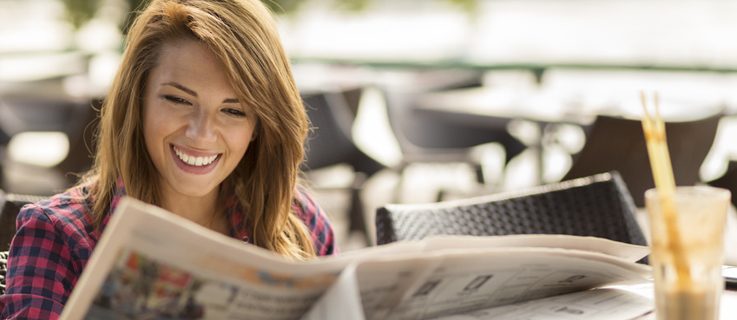The only good news is bad news? No, think some media in Germany and want to report more constructively in future. Their biggest critics are found within their own ranks.
“Gut zu wissen“ – “Good to Know”: since the end of 2016, that has been the new, unofficial slogan of the Sächsischen Zeitung, a local newspaper in the east of Germany. In every edition, the motto together with a green smiley face is emblazoned above several articles. It is a small revolution for the regional paper. Because “Good to Know” stands for a new approach in journalism.
The principle, to which the SZ has committed itself, is called constructive journalism. Instead of reporting on problems such as Islamist terror, polluted rivers or town hall scandals, the editors now deliberately feature positive topics or proposed solutions. The idea: journalism should show the world in its entirety. The media, however, report predominantly on conflicts and negative developments so as to stir up the attention of their consumers, in keeping with the old adage: The only good news is bad news. The Sächsische Zeitung wants to break through this pattern of thought: about 400 articles have now been published sporting the smiley and the motto.
Criticism: whitewashers
The concept is not new. In fact, the idea originated in the years following the Second World War. But constructive journalism has really come into action in the large media companies only in recent years. One of the best-known examples is in the pages of the
New York Times, where the American writer David Bornstein has been discussing suggestions for improving the world since 2012 in his solution-oriented column “Fixes”.
The
Sächsische Zeitung has been experimenting with this “more positive” view on the news since November 2016. Proponents of constructive journalism do not want to bracket out conflicts. But they do want to accent them differently and always present them with suggestions for solutions.
The experiment is controversial even at the
Sächsische Zeitung: “initially there was anger among the editors”, admits Oliver Reinhard, deputy head of the feature pages. Colleagues criticized the new approach as "whitewashing”. “Some called it propaganda for popular stultification.” Reinhard himself is one of the pioneers of the idea at the SZ and defended the project before other journalists at the media conference “European Newspaper Congress” in May 2017. “On no day of the year do only bad things happen”, he says. “A newspaper should show that.”
Especially women appreciate the feature
Reader response has confirmed the worth of the experiment. About 90 per cent of readers’ letters, Reinhard relates, are favourable to positive. The editors now try to place two to four constructive articles in the paper every day. Eighty per cent of an article must have “a positive, inspiring and motivating charm” to be considered “constructive”.
The data also speaks for the new approach, explains Reinhard. Smilely articles enjoy a reading rate of 4 to 18 per cent. The constructive reporting appeals especially women and people with higher educational qualifications. Advertising revenues have also risen. “But it’s not yet in our bones; the greatest difficulty in constructive journalism is to see it through in everyday practice”, Reinhard admits. Sometimes, he says, there are editions without good news. “In my opinion, the newspaper then shouldn’t even go to print.”
The online editions of the two most important German supra-regional weekly media,
Der Spiegel and
Die Zeit, have announced their intention to publish more “constructive” content. Florian Harms, former editor-in-chief of
Spiegel Online, already promised more articles in 2015 “that reveal a hopeful aspect, a way out, even in gloomy subjects”. But constructive articles are not specially marked on the platforms. Only in its print edition has
Der Spiegel given the idea a permanent place under the rubric “Before, everything used to be worse”.
Other countries are further along than Germany
In comparison with other forms of reporting, constructive journalism takes a subordinate place in Germany. As strict policy, it appears only in smaller, mainly younger media, among them
Tea after Twelve, Brandeins, Perspective Daily and
Kater Demos.
“With us, the constructive approach runs through the whole issue”, says Alexander Sängerlaub, founder and chief editor of
Kater Demos. Since 2015, his magazine has been dedicated to writing semi-annually about social and political utopias; for instance, about work and media in the future. “We can always take on a big topic. As a result, we have a lot of time and space to provide input for approaches to solutions. That’s certainly harder in the daily press.” The production is financed by crowdfunding, which the editors carry out anew for each issue. Recently, they garnered 11,000 euros. Advertising does not appear in the magazine, says Sängerlaub; the editors should remain independent.
Other countries, such as Denmark, are much farther along with constructive journalism, thinks Sängerlaub. But just now the German media landscape is markedly changing. Readers would like to have more constructive stories. “But quite honestly: in writing, we don’t really think so much about the reader”, admits Sängerlaub, and laughs. “We simply produce the kind of magazine we ourselves would like to read.”
